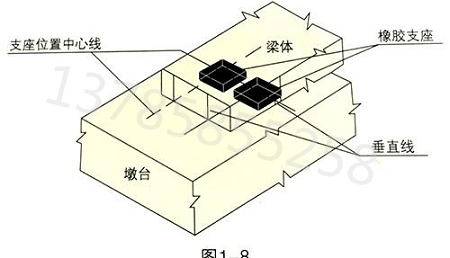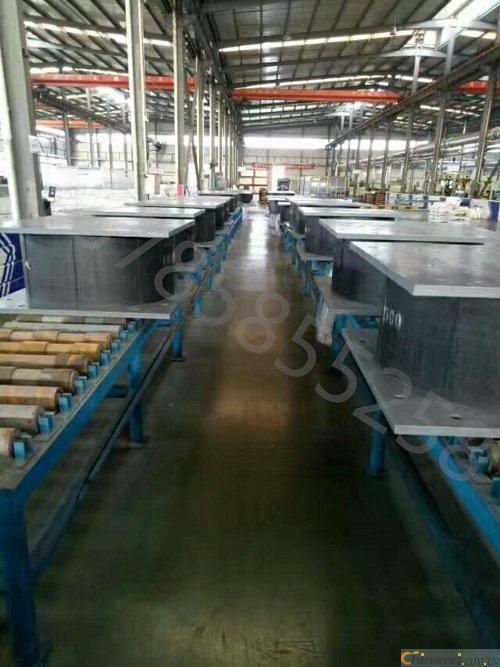Rubber bearing installation method If you want to install the rubber bearing, the key is to ensure that the bottom of the beam and the top surface of the stone are as flat and parallel as possible, so that it is closely attached to the upper and lower sides of the rubber bearing to avoid bias and off. The occurrence of empty and uneven support phenomena is as follows:
1. Remove the floating sand from the top surface of the abutment and the surface should be clean and smooth without oil. If the difference in elevation between the pier and the slab is too large, it can be adjusted with cement mortar.
2. The bottom plane of the prefabricated beam in contact with the support should be kept horizontal and level. If there is a honeycomb or inclined surface, it should be compacted and leveled with cement mortar.
3, the correct seating of the rubber bearing
The center line of the support position is drawn on the support pad by the design icon, and the cross center line is also marked on the rubber support. Place the rubber support on the bolster so that the center line of the support coincides with the center line of the design position on the abutment, and the support is in place.
When the beam is placed on the beam, the total axis of the T-beam should coincide with the centerline of the support. The longitudinal axis of the plate beam and the box girder should be parallel to the centerline of the support. For the accuracy of the drop beam, when the bridge or the box girder is spanned, the center line of the cross position of the two supports can be drawn at the bottom of the beam, and the vertical line of the center line of the two support positions is marked on the end façade of the beam. When the beam is dropped, it coincides with the center line of the line position on the pier (Fig. 1-8). Later, the number spans on the basis of a span.

4. The beam should be stable when the beam is dropped, and the bearing should be prevented from being eccentrically pressed or the initial shear deformation.
5. When installing the T-beam support, if the support is wider than the bottom of the beam rib, a reinforced concrete block or thick steel plate slightly larger than the support should be added between the support and the bottom of the beam for the transition to avoid rubber. The support is partially overloaded and stress concentrated. The reinforced concrete block or steel plate shall be bonded to the bottom of the beam with epoxy resin mortar.
6. After the rubber bearing is installed with the falling beam, under normal circumstances, the top surface should be kept horizontal, and the inclination should not exceed 5'.
7, the adjustment of the rubber bearing installation
After the rubber bearing is installed, if the following conditions are found, it should be adjusted in time:
a. Individual support is vacant and uneven force is present;
b. The bearing has a large initial shear deformation;
c. The bearing is severely biased, partially compressed, the side is convexly abnormal, and the partial is hollow.
Adjustment method: Generally, the jack can be used to lift the beam end, and a layer of cement mortar (or epoxy mortar) is applied on the upper and lower surfaces of the support. Once again, the upper and lower surfaces of the support are parallel to each other under the action of gravity, and the tops of the beam and the top of the abutment are all closely attached. At the same time, the supports at both ends of the beam are in the same plane, and the longitudinal inclination of the beam should be controlled. It is preferred that the support does not produce significant initial shear deformation.
Sales phone (V letter with the same number) QQ hotline
Http://news.chinawj.com.cn
1. Remove the floating sand from the top surface of the abutment and the surface should be clean and smooth without oil. If the difference in elevation between the pier and the slab is too large, it can be adjusted with cement mortar.
2. The bottom plane of the prefabricated beam in contact with the support should be kept horizontal and level. If there is a honeycomb or inclined surface, it should be compacted and leveled with cement mortar.
3, the correct seating of the rubber bearing
The center line of the support position is drawn on the support pad by the design icon, and the cross center line is also marked on the rubber support. Place the rubber support on the bolster so that the center line of the support coincides with the center line of the design position on the abutment, and the support is in place.
When the beam is placed on the beam, the total axis of the T-beam should coincide with the centerline of the support. The longitudinal axis of the plate beam and the box girder should be parallel to the centerline of the support. For the accuracy of the drop beam, when the bridge or the box girder is spanned, the center line of the cross position of the two supports can be drawn at the bottom of the beam, and the vertical line of the center line of the two support positions is marked on the end façade of the beam. When the beam is dropped, it coincides with the center line of the line position on the pier (Fig. 1-8). Later, the number spans on the basis of a span.

4. The beam should be stable when the beam is dropped, and the bearing should be prevented from being eccentrically pressed or the initial shear deformation.
5. When installing the T-beam support, if the support is wider than the bottom of the beam rib, a reinforced concrete block or thick steel plate slightly larger than the support should be added between the support and the bottom of the beam for the transition to avoid rubber. The support is partially overloaded and stress concentrated. The reinforced concrete block or steel plate shall be bonded to the bottom of the beam with epoxy resin mortar.
6. After the rubber bearing is installed with the falling beam, under normal circumstances, the top surface should be kept horizontal, and the inclination should not exceed 5'.
7, the adjustment of the rubber bearing installation
After the rubber bearing is installed, if the following conditions are found, it should be adjusted in time:
a. Individual support is vacant and uneven force is present;
b. The bearing has a large initial shear deformation;
c. The bearing is severely biased, partially compressed, the side is convexly abnormal, and the partial is hollow.
Adjustment method: Generally, the jack can be used to lift the beam end, and a layer of cement mortar (or epoxy mortar) is applied on the upper and lower surfaces of the support. Once again, the upper and lower surfaces of the support are parallel to each other under the action of gravity, and the tops of the beam and the top of the abutment are all closely attached. At the same time, the supports at both ends of the beam are in the same plane, and the longitudinal inclination of the beam should be controlled. It is preferred that the support does not produce significant initial shear deformation.
Sales phone (V letter with the same number) QQ hotline
Http://news.chinawj.com.cn

Brass Faucet Shower,Brass Shower Fixtures,Brass Shower Valve,Brass Shower Taps
Heshan Janno Kitchen and Bath Technology Co.,Ltd , https://www.janno-ks.com